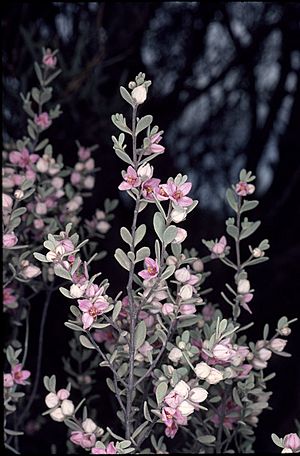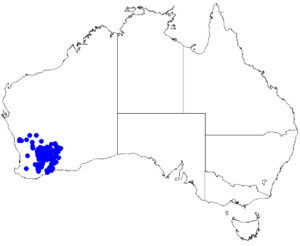Boronia ternata facts for kids
Quick facts for kids Boronia ternata |
|
|---|---|
 |
|
| B. ternata growing near Southern Cross | |
| Scientific classification | |
 |
|
| Occurrence data from Australasian Virtual Herbarium |
Boronia ternata is a special plant that belongs to the citrus family called Rutaceae. It grows only in the south-west part of Western Australia, which means it's endemic to that area. This plant is an upright shrub with many branches. It has either simple leaves or leaves made of three parts (called trifoliate leaves). Its flowers are usually white to pink and have four petals.
Contents
What Does Boronia ternata Look Like?
Boronia ternata is a shrub that can grow up to about 2 m (7 ft) tall. It has many branches, making it look bushy.
Its leaves can be simple (just one blade) or trifoliate (made of three leaflets).
- The end leaflet is shaped like an oval or a spear, measuring 2–15 mm (0.08–0.6 in) long and 1–5.5 mm (0.039–0.22 in) wide.
- The side leaflets are 2–12 mm (0.08–0.5 in) long and 1–4 mm (0.04–0.2 in) wide.
- The leaf stalk, called a petiole, can be up to 2 mm (0.08 in) long.
The flowers are white to pink. They usually grow alone, but sometimes you can find up to three flowers together on a small stalk called a pedicel, which is 0.5–4 mm (0.02–0.2 in) long.
- Each flower has four sepals (small leaf-like parts that protect the bud). These sepals are oval or spear-shaped, about 2–3.5 mm (0.079–0.14 in) long and 1–2.5 mm (0.039–0.098 in) wide.
- There are also four petals, which are the colorful parts of the flower. They start at 4–11 mm (0.16–0.43 in) long and 2–6 mm (0.08–0.2 in) wide, but they get bigger as the fruit grows.
- The flower has eight stamens (the parts that produce pollen). These stamens are different lengths, with the ones closer to the sepals being longer than those near the petals.
Boronia ternata flowers from April to November. After flowering, it produces a fruit called a capsule, which is 3–5.5 mm (0.12–0.22 in) long and 2–3.5 mm (0.079–0.14 in) wide.
How Was Boronia ternata Named?
The plant Boronia ternata was first officially described in 1839 by a scientist named Stephan Endlicher. He published his description in a book called Novarum Stirpium Decades.
The second part of its scientific name, ternata, comes from a Latin word. It means "consisting of threes," which likely refers to its leaves that often have three leaflets.
Scientists have identified six different types, or varieties, of Boronia ternata. These varieties are slightly different from each other but are all part of the same species.
Where Does Boronia ternata Grow?
This type of boronia plant grows in specific areas of Western Australia. You can find it on rolling plains, hills, rocky cliffs, and in places where the land suddenly drops off (called breakaways). These areas are part of the Avon Wheatbelt, Coolgardie, and Mallee biogeographic regions.
Is Boronia ternata Protected?
The Government of Western Australia's Department of Parks and Wildlife has listed Boronia ternata as "not threatened." This means that currently, there are enough of these plants in the wild, and they are not considered to be at risk of disappearing.

